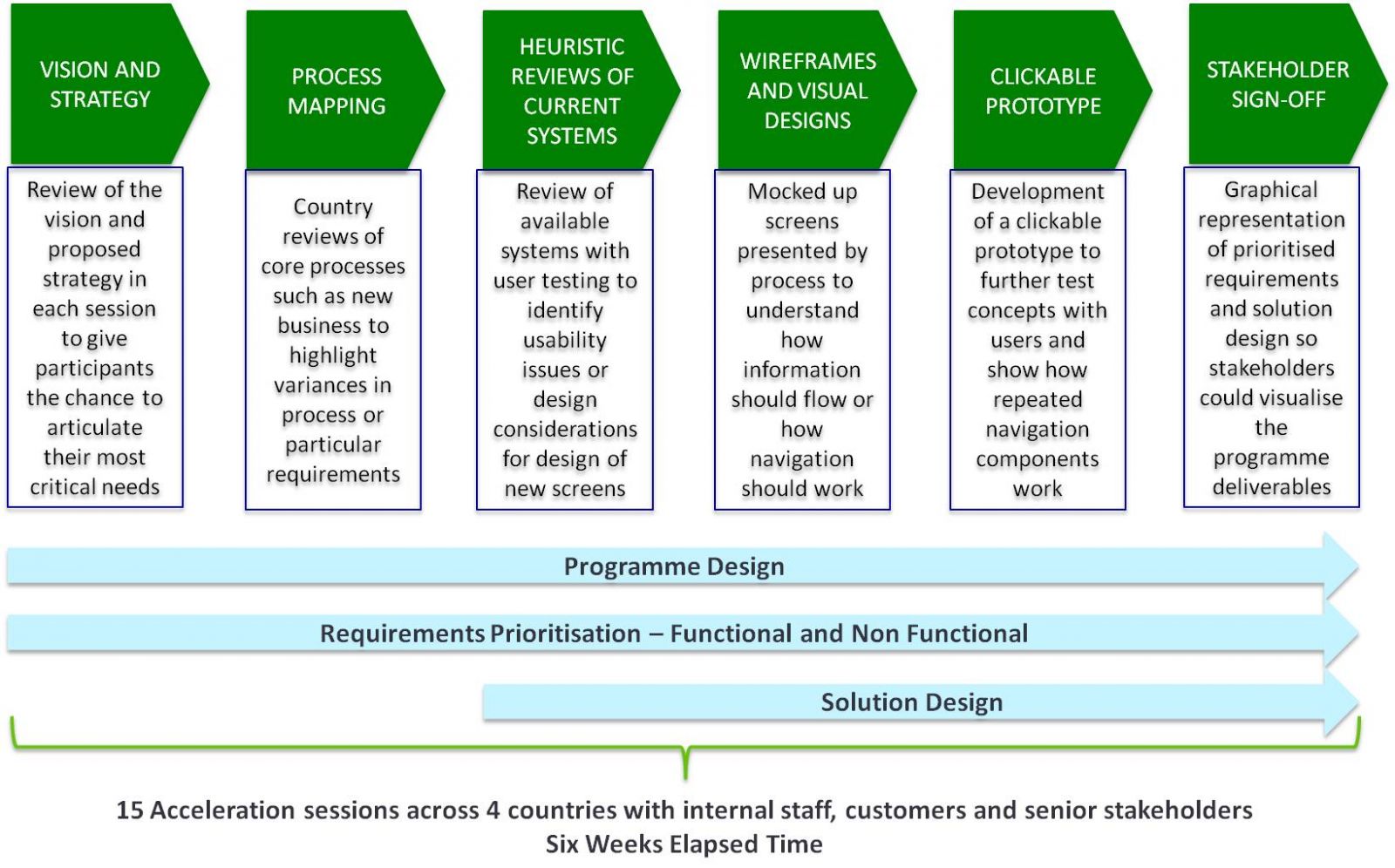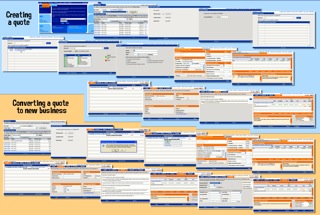Starting only with the desired outcome, and progressing through to sign-off of a complicated major investment programme - in six weeks
We have all experienced the excitement of an early concept phase – the general sense of energy moving forwards into a new programme of work. Unfortunately, the all too common scenario is that wheels start spinning when it becomes evident that not everyone is aligned, or that there is a mountain to climb in terms of education and analysis. It is not uncommon for there to be two or three attempts at getting the delivery scope and approach determined, before moving towards implementation. Worse still, some projects move to delivery too quickly then stall when it becomes clear that the framework hasn’t been set correctly.
In one recent project, bringing together a client delivery team and HeathWallace (a specialist digital design agency), BiG Innovation were able to integrate some simple design tools with an iterative collaborative process in order to build momentum and engagement around a new concept in just six weeks. This provided the client with more than enough material to move straight to implementation immediately afterwards.
BiG have spent years bringing design skills to large group interventions and have facilitated well over 100 collaborative events. However in this instance, the challenge (and the challenging timeframes) had some unique aspects:
- How could the team build a robust set of high-level requirements across 4 countries in just six weeks?
- How do you engage internal staff and customers in the Asia region to get a good understanding of what they need and get them enthused about these future developments? This was in the context of hierarchical structures and some unique cultural aspects.
Figure 1: BiG Innovation CLEAR Framework
Having worked with the client previously, BiG utilised their CLEAR framework to design the concept phase. It was clear from the outset that the project needed to engage specific stakeholder groups in four countries (Hong Kong, Malaysia, Singapore and Australia).
In response, a series of 15 Acceleration Sessions was planned, each intended to build on the outcomes from before. These sessions used a series of visual tools and techniques to build and test the requirements and design concepts, and along the way engaged with over 100 internal staff and clients.
![]()
Clarify - We knew we needed to clarify the strategic intent and connect the stakeholders with the vision quickly. We used simple visioning techniques to understand how their day-to-day work would change and capture critical needs from their perspective.
Learn – As we needed to get insightful information from local stakeholders, we needed them to understand the art of the possible. This meant teaching them about successful eBusiness transformations and what could be done technically.
Engage – You might argue that the whole process was about engagement, but we knew we had some specifics to deal with in Asia. We designed responses to make the working sessions as engaging as possible in the local context.
Activate – We knew that the success of the concept phase would be measured on being able to move into a delivery programme immediately afterwards. Hence throughout the concept phase we identified all the activities necessary to get moving quickly after sign-off.
Refine – We iterated our conclusions through the phase and recognised in the six weeks available that we wouldn’t get 100% of the detail. Where we knew additional detailed analysis was required, we captured this and built it into the programme design.
Accelerated Requirements Development
Six weeks to collect a set of high-level requirements and gain approval is a challenging timeframe in any project. The entire team (both internal and external) knew they had to get on with the task in hand and from the outset, a combined plan was built with each party being clear on their roles and responsibilities.
Working with the client project team and HeathWallace, the BiG team were able to breakthrough the requirements development challenge by thinking about how to engage stakeholders visually and iteratively, and use this process to understand their needs. Using graphical materials as much as possible, each session further developed requirements and solution options until the core needs became transparent. The process, which highlighted core requirements very quickly, is shown below:
Figure 2: Accelerated Design and Sign-Off
Each Acceleration Session built on previous learnings and therefore the level of detail and range of ‘analytical assets’ grew substantially. Being able to see the full picture meant specific issues, such as local product features or legislative requirements could be isolated and addressed along the way. In addition, due to the iterative nature of the work, specific solution design elements had several sources of information to draw on, not just one conversation. This improved the quality of the overall design.
All the materials developed in session were captured digitally and through a collaborative social networking tool, the outputs were available immediately to the entire project team to enable progression of documentation and analysis. In between each session, new inputs to the next session were developed. The team developed a perspective that they should be maximizing the value of each interaction and therefore there was a need to think clearly about each input to, and output from, any discussion.
In order to develop the required project documentation and support the process of getting to formal sign-off, parallel activities such as designing the future programme and capturing the requirements in a formal requirements document took place outside of the sessions. However, the quality of materials captured, the local context and the ability to test with local stakeholders real-time meant sign-off became a formality rather than substantive work in its own right.
Figure 3: Requirements Development in Singapore and Malaysia
.jpg)
.jpg)
A critical activity that helped to get an understanding of user requirements was the process of ‘Wireframing’ undertaken by HeathWallace. Wireframes are graphical representations of screenflows and navigation that can be tested with users. The UX designers used each session with staff and clients to develop screen flows that would work for administrators and customers using the future system.
Figure 4: From legacy, complex screenflows to simplified UX design

.jpeg)
Applying current UX thinking and design principles (including the considerations relating to mobile platforms) meant the implementation pathway became much more simple than initially anticipated. The team identified that users are much more aware of a good (and poor) experience than they are often given credit for and this was particularly the case in Asia where mobile devices are increasingly the platform of choice.
Engaging in the Region
Whilst BiG have worked in collaborative processes for many years, they knew taking on this assignment would test capabilities in terms of engagement. The concept of ‘face’ in Asia and the hierarchical structures which influence people’s willingness to speak up meant thinking about getting groups to collaborate in the absence of the direct dialogue common in the UK and US.
In terms of practical advice for anyone faced with leading a project or facilitating in the region, here are some simple pointers that you can use to improve engagement and collaboration:
- Show demonstrable respect - Pay attention to the detail in names and get a local person to review these thoroughly – watch for titles that are often missed. Allow time to share business cards at the start of a session (which are handed over using two hands and should be read on receipt) and take time to introduce yourself thoroughly as facilitator.
- Be very clear with instructions - Use written assignments to get groups working. Test these instructions with a design team to make sure they are absolutely clear.
- Design around smaller groups - Break participants into pairs or threes initially when working through assignments. This allows for more interaction but also removes the issue of ‘face’ and organisational hierarchies. You can always combine groups into larger groups when everyone has settled into a more ‘open’ way of working.
- Relax about language - Clearly it is important for final outcomes to be communicated in a language the whole group understands (this is usually English) but allow participants to process their thinking in the language which is easiest for them to communicate in - needing to translate can be disruptive to their thought processes. Actively encourage the use of local language to discuss detailed issues.
- Concentrate on detailed logistics - There are lots of rules so check all of these out in preparation. Infrastructure and equipment can be difficult to get hold of so plan ahead. If you’re using an external venue, don’t be tempted to rely on a concierge – get them to show you how the equipment works as they might not be around when you need them!
The Outcomes
In the six weeks, the combined project team successfully achieved the following outcomes:
- Progression from a strategic intent but unclear solution pathways to stakeholder sign-off of a major investment programme
- Development of a robust set of high level requirements and plans for the development of further detail where necessary
- Agreement of solution concepts and outline solution designs
- Visual design of key screens with agreed principles for other screens in detailed design
- A programme design including schedule, budget, structure and key risks
- Progression to the implementation phase without delay
The programme has now completed its build phase and is in final testing before deployment in early 2014.
 Joe Binnion
Joe Binnion
BiG Innovation design accelerated change programmes for global organisations, using collaboration to get the best out of their people and their business partners.